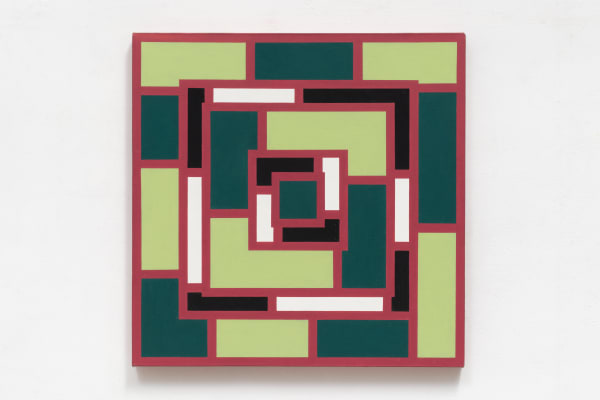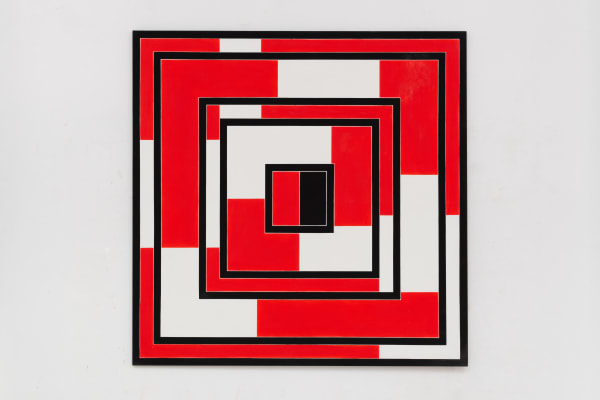Mary Webb: Extended Square
Hales is delighted to announce Extended Square, a solo exhibition of historic works by Mary Webb. Her second solo show with the gallery features paintings made between 1969 and the mid-1970s.
Mary Webb (b. 1939, London, lives and works in Suffolk, UK) is a British artist who paints in a modernist tradition, employing geometry to create a new vision of the world. Webb has dedicated her practice, spanning almost six decades, to the exploration of formal abstraction through painting, printmaking and collage. She studied at Newcastle University on the infamous Fine Art ‘Basic’ course run by Richard Hamilton and Victor Pasmore, before completing her postgraduate studies at Chelsea School of Art in 1964.
Extended Square marks a prolific period for the artist who, at the time, had just begun teaching at Norwich School of Art – she would paint in her studio at the art school as well as at her home studio in Streatham, London. In 1971, Webb’s solo exhibition of works from this period inaugurated the art school’s newly opened gallery and 1974 saw her paintings included in the Serpentine Summer Show. That same year Red and Green VI, which is part of Hales’ solo exhibition, was exhibited in the John Moores Painting Prize, Liverpool.
Webb paints resolutely square, measured abstraction which celebrates bold colour relationships and complex geometric compositions. In these significant early works, she begins to deconstruct the grid – dismantling, cutting, splicing and layering to create an endless set of configurations. Webb is already exploring the formal elements and processes that she will remain dedicated to throughout her career over the next fifty years.
The exhibition traces the progressive formal complexities in Webb’s practice, from the earliest piece, Extended Square (1969) – a painting of concentric squares, which slot into place with bold simplicity – to the 1977 work, Dunwich and its infinite possibilities. The never-ending maze-like lattice of Dunwich explores the implication of the vertical and the right angle on the composition. Webb looked outwards making this painting, at the pine trees of Dunwich, whose right-angled stumps sparked the initial concept.
Intentionality is evident in every line, shape and colour in the formally abstract works. Requiring careful planning, each painting is meticulously calculated and executed. Webb’s layering of the deconstructed grid, which creates overlaps, inlets, and abrupt stops, is mapped out prior to starting to paint. The structure of making is of prime importance – the concept for each work is explored and pushed forward in moments of reflection, in the time in between making each painting.
Webb’s uncompromising style of painting characterises the two-dimensionality of the picture plane. She builds up an exact, even application of oil paint in thin layers, enhancing the flatness of the physical surface. Illusionistic space is created by chromatic relationships in unequivocal pictorial statements. Webb’s use of the grid as a formal device means that each element is carefully balanced and supported by their counterparts. There is a meditative quality to the underlying, unifying grid, which creates a balanced field of visual perception. Some paintings are framed and bound by an edge and in others the grid seems to extend beyond the canvas, evoking limitless space.
Webb’s masterful use of colour as an abstract language creates vibrant, experiential paintings. Forever experimenting and playing with space within the single motif of the square canvas, Webb dislocates the grid in order to go beyond it. In her rigorous practice she never deviates from her geometric vocabulary, making visually resonant works.










